
A common problem in home networks is a sluggish Wi-Fi connection, which is frustrating to all family members and even when the network is shared with visitors. At its worst, the problems could cause videos to stutter, downloads to stall, and remote work to suffer.
Fortunately, there are a few things one can do to remedy some of the issues that relate to lousy Wi-Fi networks. We've collected some of the best tips on how one can try and fix the problems, regardless of the service provider.
The most typical problems with Wi-Fi have to do with poor positioning of the router itself, barriers between the router and the devices, and other networks. A router is a device that is part of the network, either as a standalone device or as part of the modem. It directs, or routes, traffic between the home network and the internet.
The first step to determining what might be wrong is to test the network speed. This should be initially done with a wired Ethernet connection, is possible, which will give the best result available. It can also provide straight away a reason for a sluggish network. And if not, this result can be used as a control when compared to a wireless result.
The test can be performed in the following way:
The final result should look something like this:
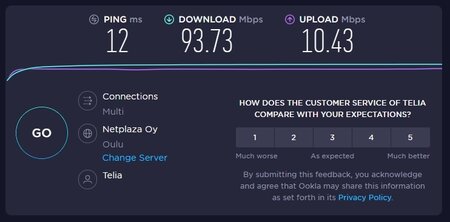
Here the results are for a 100/10 Mbit internet connection, and the results reflect the nominal speed. The number on the left, ping, reflects the latency to the server. Usually should be under 100 ms, unless the test is performed far away from a test server. The effects of a high latency are largely only experienced in online gaming. So-called lag is an effect of high latency.
The middle number is the one that is the most consequential. It shows how fast your computer can receive data from the server. The bigger the number, the faster you can download files and load content from the web. The number on the right shows the speed at which your computer is able to send data to the server. This is in most cases much less important unless uploading content to the web, eg. YouTube, or servers.
These figures should be compared to the speeds promised by the internet service provider to determine if something is indeed wrong with the speed of the connection. If the figures are close to what has been promised, there's no problem with the actual internet connection.
However, if there is a significant difference, one should contact the ISP for a fix on the issue.
The next step would be to determine, whether that specific spot in the house doesn't seem to get a good Wi-Fi connection. If possible, use different devices in the same location to find out if the situation is the same on all of them.
Sometimes there's a simple explanation, like a thick wall, that might not let the wireless connection to pass through.
If you've managed to find out that only one device seems to suffer from sluggish Wi-Fi, it's time to try and resolve the issue on the device.
The fact is that not all computers play nicely with every router and vice versa. There might be still some ways to fix this situation with these steps:
Especially desktop computers sometimes have built-in adapters on the motherboard that offer atrocious connections.
This is mostly for those that live in a densely populated area. When a lot of residents have separate Wi-Fi networks, they might create congestion. If the same channels are used a lot, the networks have to compete for the radio frequencies, which could result in worse experiences for all.
The easiest solution for this problem is to find a less congested Wi-Fi channel. There is a finite number of Wi-Fi channels that can be used. However, oftentimes routers use default channels, which means that users tend to use the same channel when there are other channels without any networks.
While Wi-Fi networks do use multiple channels to transmit the data and sharing channels with other networks, by and large, doesn't cause issues, sometimes there is too much traffic for all that data to get through.
In fact, overlapping default channels aren't necessarily as bad as overlapping a secondary channel with another network's primary one.
To see what the channel situation for your specific case is, there's an amazing tool for Android devices called WiFi Analyzer, available on Google Play.
Here's what the channels look like in our case:
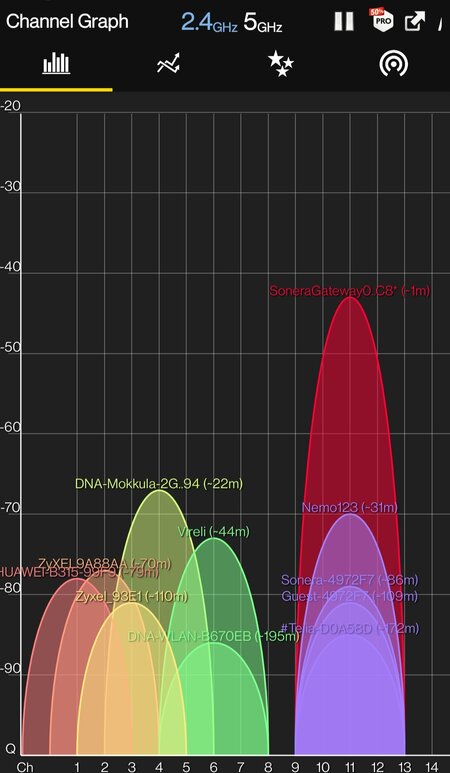
As one can see, nearly all channels have network activity. In this case, our own network is the red one, which shares the channel with four other networks that reach the location. In this case, these other networks pose no issues to our network..
If possible, always use channels 1, 6, or 11 in a 2.4 GHz wireless network. Only use other channels if neighbors use channels that indirectly overlap your network.
In our example, problematic channels are all channels from 1 to 10, since they are much more congested and likely slow down each other's networks.
If you determine that it is worth switching the Wi-Fi channel, find the information on how to change the channels for your router in the manual. Change to a channel that is least congested, while remembering to not indirectly overlap with other channels.
Even in cases where all channels seem to be very crowded, there's still a possibility to change the Wi-Fi technology from 2.4 GHz to 5 GHz.
The age-old standard Wi-Fi uses a 2.4 GHz frequency but newer devices also support the new 5 GHz frequency. If all your devices support 5 GHz networks, you might want to switch to that instead.
We found out by using WiFi Analyzer that in our case, there are barely any other 5 GHz networks in our area.

Congested 2.4 GHz frequencies
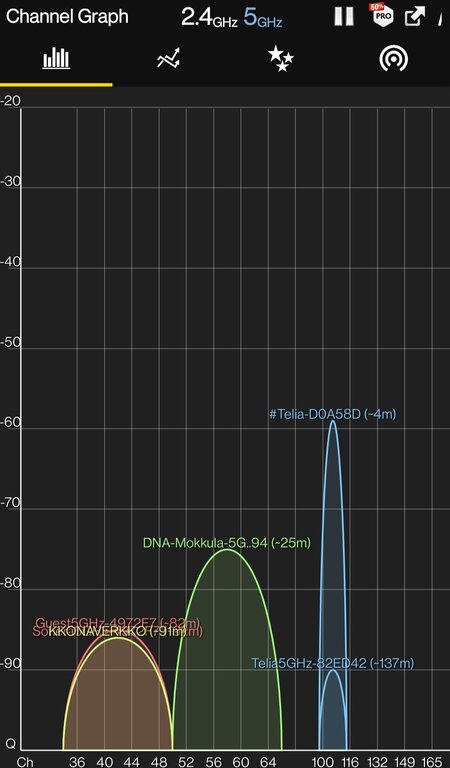
Plenty of room in 5 GHz
However, it's worth noting that not all devices support the newer 5 GHz networks. Unless your router supports both networks simultaneously or all your devices are compatible with 5 GHz, this is obviously not a good solution.
One of the tips that we received has to do with Wi-Fi networks that have multiple channels enabled. In default mode, networks use a 20 MHz frequency range, or channel, for their network.
However, newer routers can also provide an option where the network can automatically change between using 20, 40, or 60 MHz. Theoretically, using three channels should provide better throughput.
Unfortunately, when using multiple channels, the signal strength weakens, and users might not get as good of a connection rather away from the router. It is also possible that some of the older devices used in the network as not compatible with this solution.
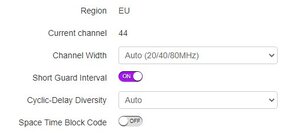
If you've tried our tips so far but the problem persists, we suggest you try the automatic channel width setting to just 20 MHz, this might allow better range and penetration.
Often the placement of the router is not the best work the network, even when it might make other types of sense.
The aforementioned WiFi Analyzer helps with determining what might be a good spot for the router. Moving around the house and keeping an eye on the signal graph can help to find out dark spots (where the signal graph is at its lowest). Move the router to a new place, considering the previous dark spots. You might have to do this again, depending on the results.
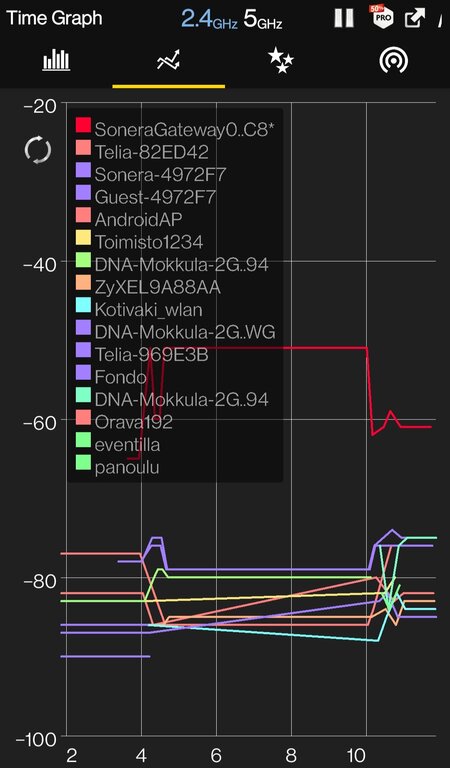
The above graph shows how moving closer affected the signal strength (red graph).
If you haven't protected your network with a password, someone might be connecting to your network without your knowledge. This might be the reason that the connection seems slower than it should be. Look for how to set a password on the Wi-Fi network from the manual of the router.
Some devices automatically use open networks, so it might not be malicious at all. This is just one of the reasons why protecting your network with a password is important.
If your home happens to be very large, maze-like with thick walls, or on several levels, it might be that you are simply fighting against physics. The signal will simply dissipate after a certain range, and obstacles make the range much worse.
This is where a so-called mesh network can help. Unfortunately in most cases, it requires some new purchases. A mesh network is essentially a collection of routers that connect to each other to cover a larger area. Unlike Wi-Fi extenders, these routers act as one router, or connection point, which makes them easier to use. There are endless options for mesh routers at different price points.
However, before investing in a set of mesh routers, make sure that the range is indeed the problem, and not something else.
If every single Wi-Fi-enabled device that you use is fairly new, perhaps manufactured after 2021, you might be able to take advantage of a very new 6 GHz technology. This WiFi 6E standard (also known as 802.11ax) was introduced in 2020.
This 6 GHz frequency range was enabled for Wi-Fi first with WiFi 6E, which means that there is usually very little traffic. It also offers many more channels, which means more room for networks than on 2.4 GHz or 5 GHz.
The problem with the new WiFi 6E is that every device needs to support it for you to get the full benefit of it. Fortunately, some newer routers can do simultaneously both WiFi 6E and older standards, which could allow use it even with older devices in the house.
The upcoming WiFi 7 will also support the 6 GHz frequency range, which means that it will be the network frequency of the future. So in case your devices support WiFi 6E but your router doesn't, perhaps it's worth considering upgrading to a WiFi 6E-capable router.
Even if WiFi 6E isn't applicable in your case, and other means so far have been exhausted, perhaps a new router is the best option. An old, worn-down router that doesn't support modern standards might not be able to keep up with the data demands.
By upgrading the router, one can improve the range, the speed, and even the number of connected devices. There are a lot of options available, so be sure to know what your issue with the current router is. If it's the range, choose a new one with better antennas, for example.
As silly as it might sound, this is oftentimes the best solution, when applicable. Those devices that can be connected to the network using a good-old Ethernet cable, are best connected with it. Obviously, this isn't a solution for most devices these days, as wireless connections are ubiquitous.
However, Ethernet is very reliable and fast, and congestion isn't a problem, so take advantage of a wired connection when available.
For additional help and questions, you might want to join our forums. Feel free to ask questions on the PC Hardware Help forum.
- What Causes Wi-Fi Problems?
- Measure Speeds First
- Do Problems Affect All Devices?
- Only One Device Has Problems. What to Do?
- Change The Wi-Fi Channel
- Switch From 2.4 GHz To 5 GHz
- Channel Width
- Find a Good Spot for the Wi-Fi Router
- Is Someone Else Using My Wi-Fi?
- Mesh Network, Would That Help?
- Enable 6 Ghz Channels
- Switch the Router
- Switch to Ethernet
- Additional Help
What Causes Wi-Fi Problems?
The most typical problems with Wi-Fi have to do with poor positioning of the router itself, barriers between the router and the devices, and other networks. A router is a device that is part of the network, either as a standalone device or as part of the modem. It directs, or routes, traffic between the home network and the internet.
Measure Speeds First
The first step to determining what might be wrong is to test the network speed. This should be initially done with a wired Ethernet connection, is possible, which will give the best result available. It can also provide straight away a reason for a sluggish network. And if not, this result can be used as a control when compared to a wireless result.
The test can be performed in the following way:
- Unplug or close all other devices from the router whether connected wirelessly or with a wire. This includes shutting the smart TV, pausing all streaming apps, turning off Wi-Fi on mobile devices, etc.
- Close all other apps on the test computer, except for the browser.
- Open SpeedTest.net on the browser and follow instructions to perform the network test. Usually, this means simply pressing the Go button and waiting for the test to finish.
The final result should look something like this:

Here the results are for a 100/10 Mbit internet connection, and the results reflect the nominal speed. The number on the left, ping, reflects the latency to the server. Usually should be under 100 ms, unless the test is performed far away from a test server. The effects of a high latency are largely only experienced in online gaming. So-called lag is an effect of high latency.
The middle number is the one that is the most consequential. It shows how fast your computer can receive data from the server. The bigger the number, the faster you can download files and load content from the web. The number on the right shows the speed at which your computer is able to send data to the server. This is in most cases much less important unless uploading content to the web, eg. YouTube, or servers.
These figures should be compared to the speeds promised by the internet service provider to determine if something is indeed wrong with the speed of the connection. If the figures are close to what has been promised, there's no problem with the actual internet connection.
However, if there is a significant difference, one should contact the ISP for a fix on the issue.
Is the problem with your devices?
The next step would be to determine, whether that specific spot in the house doesn't seem to get a good Wi-Fi connection. If possible, use different devices in the same location to find out if the situation is the same on all of them.
Sometimes there's a simple explanation, like a thick wall, that might not let the wireless connection to pass through.
Only One Device Has Problems. What to Do?
If you've managed to find out that only one device seems to suffer from sluggish Wi-Fi, it's time to try and resolve the issue on the device.
The fact is that not all computers play nicely with every router and vice versa. There might be still some ways to fix this situation with these steps:
Especially desktop computers sometimes have built-in adapters on the motherboard that offer atrocious connections.
- Update your computer's Wi-Fi adapter drivers.
- First you need to figure out what Wi-Fi adapter is installed in your computer. This might be found on the computer or motherboard manual. Changing adapter settings by trial and error might also work.
- Especially desktop computers sometimes have built-in adapters on the motherboard that offer atrocious connections.
- If this seems to be the case, buying a standalone Wi-Fi adapter might be the best option.
Change The Wi-Fi Channel
This is mostly for those that live in a densely populated area. When a lot of residents have separate Wi-Fi networks, they might create congestion. If the same channels are used a lot, the networks have to compete for the radio frequencies, which could result in worse experiences for all.
The easiest solution for this problem is to find a less congested Wi-Fi channel. There is a finite number of Wi-Fi channels that can be used. However, oftentimes routers use default channels, which means that users tend to use the same channel when there are other channels without any networks.
While Wi-Fi networks do use multiple channels to transmit the data and sharing channels with other networks, by and large, doesn't cause issues, sometimes there is too much traffic for all that data to get through.
In fact, overlapping default channels aren't necessarily as bad as overlapping a secondary channel with another network's primary one.
To see what the channel situation for your specific case is, there's an amazing tool for Android devices called WiFi Analyzer, available on Google Play.
Here's what the channels look like in our case:

As one can see, nearly all channels have network activity. In this case, our own network is the red one, which shares the channel with four other networks that reach the location. In this case, these other networks pose no issues to our network..
If possible, always use channels 1, 6, or 11 in a 2.4 GHz wireless network. Only use other channels if neighbors use channels that indirectly overlap your network.
In our example, problematic channels are all channels from 1 to 10, since they are much more congested and likely slow down each other's networks.
If you determine that it is worth switching the Wi-Fi channel, find the information on how to change the channels for your router in the manual. Change to a channel that is least congested, while remembering to not indirectly overlap with other channels.
Switch From 2.4 GHz To 5 GHz
Even in cases where all channels seem to be very crowded, there's still a possibility to change the Wi-Fi technology from 2.4 GHz to 5 GHz.
The age-old standard Wi-Fi uses a 2.4 GHz frequency but newer devices also support the new 5 GHz frequency. If all your devices support 5 GHz networks, you might want to switch to that instead.
We found out by using WiFi Analyzer that in our case, there are barely any other 5 GHz networks in our area.

Congested 2.4 GHz frequencies

Plenty of room in 5 GHz
However, it's worth noting that not all devices support the newer 5 GHz networks. Unless your router supports both networks simultaneously or all your devices are compatible with 5 GHz, this is obviously not a good solution.
Channel Width
One of the tips that we received has to do with Wi-Fi networks that have multiple channels enabled. In default mode, networks use a 20 MHz frequency range, or channel, for their network.
However, newer routers can also provide an option where the network can automatically change between using 20, 40, or 60 MHz. Theoretically, using three channels should provide better throughput.
Unfortunately, when using multiple channels, the signal strength weakens, and users might not get as good of a connection rather away from the router. It is also possible that some of the older devices used in the network as not compatible with this solution.

If you've tried our tips so far but the problem persists, we suggest you try the automatic channel width setting to just 20 MHz, this might allow better range and penetration.
Move the Router
Often the placement of the router is not the best work the network, even when it might make other types of sense.
The aforementioned WiFi Analyzer helps with determining what might be a good spot for the router. Moving around the house and keeping an eye on the signal graph can help to find out dark spots (where the signal graph is at its lowest). Move the router to a new place, considering the previous dark spots. You might have to do this again, depending on the results.

The above graph shows how moving closer affected the signal strength (red graph).
Stop Other From Stealing Your Wi-Fi
If you haven't protected your network with a password, someone might be connecting to your network without your knowledge. This might be the reason that the connection seems slower than it should be. Look for how to set a password on the Wi-Fi network from the manual of the router.
Some devices automatically use open networks, so it might not be malicious at all. This is just one of the reasons why protecting your network with a password is important.
Mesh Network, Would That Help?
If your home happens to be very large, maze-like with thick walls, or on several levels, it might be that you are simply fighting against physics. The signal will simply dissipate after a certain range, and obstacles make the range much worse.
This is where a so-called mesh network can help. Unfortunately in most cases, it requires some new purchases. A mesh network is essentially a collection of routers that connect to each other to cover a larger area. Unlike Wi-Fi extenders, these routers act as one router, or connection point, which makes them easier to use. There are endless options for mesh routers at different price points.
However, before investing in a set of mesh routers, make sure that the range is indeed the problem, and not something else.
Enable 6 Ghz Channels
If every single Wi-Fi-enabled device that you use is fairly new, perhaps manufactured after 2021, you might be able to take advantage of a very new 6 GHz technology. This WiFi 6E standard (also known as 802.11ax) was introduced in 2020.
This 6 GHz frequency range was enabled for Wi-Fi first with WiFi 6E, which means that there is usually very little traffic. It also offers many more channels, which means more room for networks than on 2.4 GHz or 5 GHz.
The problem with the new WiFi 6E is that every device needs to support it for you to get the full benefit of it. Fortunately, some newer routers can do simultaneously both WiFi 6E and older standards, which could allow use it even with older devices in the house.
The upcoming WiFi 7 will also support the 6 GHz frequency range, which means that it will be the network frequency of the future. So in case your devices support WiFi 6E but your router doesn't, perhaps it's worth considering upgrading to a WiFi 6E-capable router.
Switch the Router
Even if WiFi 6E isn't applicable in your case, and other means so far have been exhausted, perhaps a new router is the best option. An old, worn-down router that doesn't support modern standards might not be able to keep up with the data demands.
By upgrading the router, one can improve the range, the speed, and even the number of connected devices. There are a lot of options available, so be sure to know what your issue with the current router is. If it's the range, choose a new one with better antennas, for example.
Switch to Ethernet
As silly as it might sound, this is oftentimes the best solution, when applicable. Those devices that can be connected to the network using a good-old Ethernet cable, are best connected with it. Obviously, this isn't a solution for most devices these days, as wireless connections are ubiquitous.
However, Ethernet is very reliable and fast, and congestion isn't a problem, so take advantage of a wired connection when available.
Additional Help
For additional help and questions, you might want to join our forums. Feel free to ask questions on the PC Hardware Help forum.












